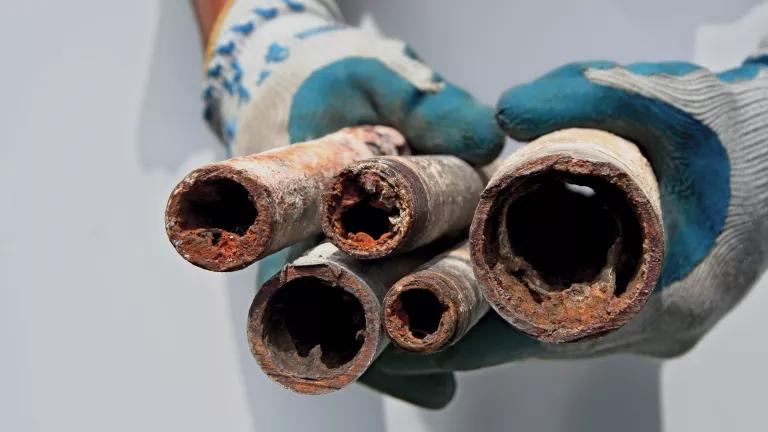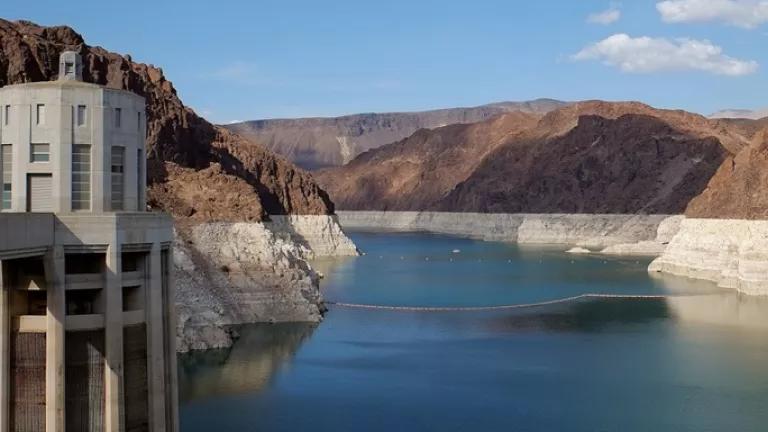
New proposed Lead and Copper Rule Improvements are a big step forward, but some provisions will have deep equity implications for environmental justice and low-income communities.
Flint resident Melissa Mays needed 58 bottles of water just to make Thanksgiving dinner for her family. The Flint water crisis represented government failure at the city, state, and federal levels. While Flint is not completely “fixed” and litigation is ongoing, the crisis also forced a national reckoning with the vulnerability of the nation’s aging water infrastructure.
In the wake of the revelations about the severity of the water crisis in Flint, MI, people from communities across the country in places like Pittsburgh, PA, Newark, NJ and Benton Harbor, MI stood up and applied pressure on local officials, the U.S. Environmental Protection Agency (EPA) and the White House to address the crisis in their communities. They organized themselves to provide their knowledge of local circumstances and on-the-ground realities, to highlight problems, document health threats, and pressure officials to address the issues.
In Flint, NRDC supported impacted community groups and allies on the frontlines to use targeted media strategies, political pressure, and public disclosures of water testing to shed light on the crisis. NRDC-filed litigation on behalf of local citizens in Flint and went on to help Michigan become the national leader on lead in drinking water policies in homes and schools and childcare centers, demonstrating that the power of community voices calling attention to the safety of their water cannot be ignored.
In response, President Biden in his first State of the Union address proclaimed that we must get the lead pipes out across the country and has continued to echo that commitment in every State of the Union address since. By requiring replacement within 10 years, the new Lead and Copper Rule Improvements, is the biggest step EPA has ever taken in replacing LSLs across the country. The final rule is an opportunity to make good on the president’s public health and environmental justice commitments that will put our communities' health first.
The LCRI also includes updates in testing protocols, lowering the lead action level from 15 to 10 parts per billion (ppb) and requiring utilities to complete lead service line inventories by 2024. The Rule seeks to end the practice of supplying drinking water to homes through toxic lead pipes that have threatened the health and well-being of families in all 50 states for more than a century.
America’s Lead Problem and its Impact on Environmental Justice Communities
Our inadequate drinking water infrastructure is posing health risks to millions of Americans. Many of the underground pipes in our drinking water distribution systems are 100 years old or more, often operating well beyond their design life. In addition, about 9 million lead service lines connect the water main to residences of about 22 million Americans.
An NRDC analysis of EPA data shows that between January 1, 2018, and December 31, 2020, 186 million people in the United States—a staggering 56 percent of the country’s population—drank water from water systems detecting lead levels exceeding 1 ppb of lead (the maximum level recommended by the American Academy of Pediatrics for children’s drinking water in schools). More than 61 million people were served by- drinking water systems that detected lead levels that exceeded the limit of 5 ppb set by the Food and Drug Administration for bottled water.
It is well-established by medical experts that there is no safe level of lead exposure and it has detrimental impacts on both children and adults. Lead in drinking water disproportionately impacts Black and brown communities.
A study by Metropolitan Planning Council showed that, “65% of the state’s Black and Latinx residents, and 42% of Illinois’ Asian-American and Native American populations, are living in communities containing 94% of the state’s known lead service lines; meanwhile, only 30% of the state’s white population is living in those same communities.” A similar study of New York City found that, “areas with higher Hispanic/Latino populations were 15% more likely to have lead service lines than majority non-Hispanic White neighborhoods;” and correlations have been found between historic redlining and increased risk of lead contamination among African-American households.
Furthermore, our colleague Chakena D. Perry, in a recent article with Harvard Public Health Magazine referenced a 2020 study indicating that “prenatal lead exposure increases the risk of low birth weight, and even low-level exposure in utero can cause permanent damage to a developing fetus’s nervous system, and later behavioral and learning disabilities.” This is especially dangerous for Black women and pregnant persons, who are already “three times more likely to die from pregnancy-related complications than white women.”
NRDC’s 2020 report “Watered Down Justice” found communities of color and low-income communities experience higher rates of drinking water violations than other communities. Systemic disinvestment in water infrastructure across the country has demonstrated that this issue is prevalent and that there is unequal access to safe drinking water and related water infrastructure. To ensure communities have safe, sufficient and affordable water, addressing lead pipes and related challenges should be taken into account. The color of one’s skin and their zip code should not make the difference between safe water and water that could negatively impact your health.
“Getting the Lead Out” Depends on the Timeline and If Utilities Will Pay for It
For the communities that will get the lead pipes out in 10 years (or hopefully less) this is a good thing. Too often, communities of color and low-income communities face a higher burden of lead exposure throughout their lifetimes. The faster we can get the pipes out, the better off communities—especially overburdened, environmental justice communities—will be.
Unfortunately, the new proposed rule will allow cities with more than 100,000 lead service lines, and potentially hundreds or even thousands of other communities to complete replacement over a longer time period. In the case of Chicago, it could be 40 to 50 or more years! Cleveland, New York City, and potentially others could also have an extended timeline. For those living in these “loophole” cities, it is deeply problematic that generations of children in these cities will grow up and then continue to drink lead contaminated water at their high school reunions.
Equally as important, the rule does not require water systems to cover the full cost of the lead pipe replacement (although the EPA “strongly encourages” it). This is concerning, given this recent scientific study showing that, when water utilities ask property owners to cover the cost of replacing the lead pipe running under their property, people in wealthier white neighborhoods, who can afford to pay, are more likely to benefit from lead pipe removal programs than people in low-income communities of color.
Michigan was the first state to update their Lead and Copper Rule, which includes the requirement that utilities pay to replace the entire line. This provision is more equitable because it ensures that those who can’t afford it (and renters whose landlords will not pay for it) will still have their lead line(s) replaced.
Our colleague Larry Levine goes into detail about this in his blog, “Yes, we CAN get the lead out—without making water bills unaffordable.” He outlines how we can make this win-win happen, which would keep water utilities solvent, while ensuring that the bills are not out of reach for those who need help paying them. As we’ve seen during the COVID pandemic, access to drinking water is essential for public health; therefore drinking water must not only be safe but must also be affordable.
What Must Happen Now?
For advocates in cities that might be granted an extended timeline, or where lower income residents cannot afford to replace lead pipes at their own expense, there is an opportunity to make change happen. The EPA’s proposed Lead and Copper Rule Improvements is simply a proposal. We can strengthen and improve it to ensure it is as strong and robust as possible.
One opportunity to let EPA hear what communities think will come in the form of a virtual public hearing scheduled for Tuesday, January 16. It is vitally important that we let the EPA know that it is their responsibility to ensure that safe drinking water is fulfilled as a human right.
The other way to tell the EPA that we’ve got to fix some of these issues is to submit a written comment by Monday, February 5th, outlining how it should be strengthened so that all people across the country can have equitable access to safer drinking water.
Make your voice heard by submitting your comment here and tell the EPA to finalize strong lead in drinking water protections.
The EPA’s Lead and Copper Rule Improvements are a big step forward, but in order to get the best rule over the finish line, we must call for these changes during the comment period to ensure equal and equitable access for lead pipe removal across the country.




